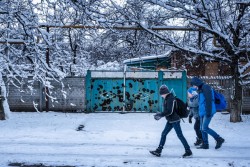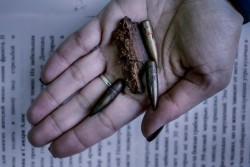 寄付方法のご案内
寄付方法のご案内
 ご寄付による支援例・成果
ご寄付による支援例・成果
 領収書
領収書
 その他のご協力方法
その他のご協力方法
 個人のみなさま
個人のみなさま
 学校・園のみなさま
学校・園のみなさま
 大学生ボランティア
大学生ボランティア
【2017年12月21日 ジュネーブ/ キエフ(ウクライナ)発】
ウクライナ東部は、現在地球上で最も多くの地雷が埋まっている場所のひとつです。地雷、不発弾などの爆発性戦争残存物(ERW)が散乱する地域に暮らし、遊び、学校に通う子どもたち22万人が脅かされています。
 |
|
© UNICEF/UN0150885/Gilbertson VII Photo |
|
学校に歩いて登校する子どもたち。(2017年11月27日撮影) |
「4年前には子どもたちが安全に遊べた場所が、今では殺傷能力のある爆発物で台無しにされていることは、許しがたいことです」とユニセフ(国連児童基金)・ウクライナ事務所代表のジオバンナ・バルベリスは述べました。「すべての紛争当事者は、このような地域を汚染し子どもたちを常に命の危険やけがをするリスクに晒すような、非道な兵器の使用を今すぐ止めるべきです」
入手可能なデータによると、今年1月から11月の間に、ウクライナ東部に長さ500キロメートルにわたって延びる政府と非政府勢力の支配地域を隔てる境界線地域は、戦闘が最も激しい場所で、平均して週に1人の割合で子どもが紛争に関連した被害に遭っています。
子どもたちが負傷する主な原因は、地雷、爆発性戦争残存物、ならびに不発弾によるもので、同じ期間に記録された全死傷者の約3分の2を占めています。多くの子どもたちは一生、障がいを抱えて生きることになります。
爆発物を拾い上げたときです。14歳の男の子アレクシーは、ユニセフ職員にこう話しました。「拾ったときに何かを押したみたい。そしたら爆発した。血だらけになって指がダラリとぶら下がっていた。僕はとても怖くなって震え始めた。気を失いそうになったんだ」
 |
|
© UNICEF/UN0150881/Gilbertson VII Photo |
|
学校の校庭で見つかった銃弾。(2017年11月27日撮影) |
地雷などの爆発兵器は、水道、電気やガスの施設など生活に不可欠な社会インフラも危険に晒します。今月初めに、35万人近くに水を供給するドネツク浄水場で不発弾が見つかりました。今年だけで、浄水場に爆発物処理団体が呼ばれたのは13回にのぼります。
ユニセフは2015年以来、パートナー団体と協力して、ウクライナ東部の50万人以上の子どもたちに対して地雷教育講座を実施してきました。講座では、子どもたちに、地雷、不発弾や爆発性戦争残存物からいかに身を守るかを教えます。ユニセフは、現在も続く紛争の影響を受ける子どもたち27万人に対して心理社会ケアも提供してきました。
ユニセフが2017年に、ウクライナ東部の子どもたちとその家族を支援するために緊急要請した必要資金のうち獲得できたのはわずか46%です。なかでも、子どもたちを対象にした地雷教育や心理社会支援などを含む子どもの保護分野での活動は、必要資金の73%が不足しています。
ユニセフは、すべての紛争当事者に対して、ミンスクで署名された停戦合意を改めて実行し、地雷除去活動や復旧作業を進めるための許可を求めます。
【関連ページ】
シェアする
